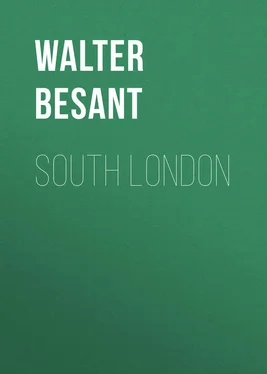Walter Besant - South London
Здесь есть возможность читать онлайн «Walter Besant - South London» — ознакомительный отрывок электронной книги совершенно бесплатно, а после прочтения отрывка купить полную версию. В некоторых случаях можно слушать аудио, скачать через торрент в формате fb2 и присутствует краткое содержание. Жанр: foreign_antique, foreign_prose, на английском языке. Описание произведения, (предисловие) а так же отзывы посетителей доступны на портале библиотеки ЛибКат.
- Название:South London
- Автор:
- Жанр:
- Год:неизвестен
- ISBN:нет данных
- Рейтинг книги:3 / 5. Голосов: 1
-
Избранное:Добавить в избранное
- Отзывы:
-
Ваша оценка:
- 60
- 1
- 2
- 3
- 4
- 5
South London: краткое содержание, описание и аннотация
Предлагаем к чтению аннотацию, описание, краткое содержание или предисловие (зависит от того, что написал сам автор книги «South London»). Если вы не нашли необходимую информацию о книге — напишите в комментариях, мы постараемся отыскать её.
South London — читать онлайн ознакомительный отрывок
Ниже представлен текст книги, разбитый по страницам. Система сохранения места последней прочитанной страницы, позволяет с удобством читать онлайн бесплатно книгу «South London», без необходимости каждый раз заново искать на чём Вы остановились. Поставьте закладку, и сможете в любой момент перейти на страницу, на которой закончили чтение.
Интервал:
Закладка:
A hundred years of rest from the 'army,' as the 'Chronicle' calls the Danes, gave Southwark time to grow. It is spoken of by the Danish historian as an 'emporium.' I understand from the use of this word that the trade of London was carried on principally by way of Dover, because the seas were swarming with pirates. Southwark was a halting-place and a resting-place, such as Thorney had been of old.
The prosperity of the settlement, however, received another blow when the Danes once more, mindful of their former victories, sailed up the river with hope of again taking London. Southwark was defenceless. There was never any wall about the place: its population was migratory. When the enemy appeared the people of Southwark retreated across the Bridge. The Danes landed, pillaged, and burned; they then went away. Some of the people returned, especially the fishermen, whose huts were easily repaired. When, however, the attacks became more frequent, and the Danes appeared every year, Southwark was deserted. But in London itself they were grievously disappointed; for their grandfathers had told them that it was a feeble and a helpless place, perfectly incapable of resistance, with walls through whose wide gaps a whole army could march; and they fondly expected to find it in the same condition. But it had been growing, unseen by them, in population and resource and power.
In the year 992 the City showed its strength in a manner which was extremely startling to the Danes; for it equipped a great fleet, manned the ships with stout-hearted citizens, sent the ships down the river, met the Danish fleet, engaged them, and routed them with great slaughter. Two years later they returned, eager for revenge – the revenge which they vainly sought in six successive sieges. The army on this occasion consisted of Norsemen and Danes in alliance, under the two kings, Olaf of Norway and Swegen of Denmark. They were firmly resolved to take the City: with their warriors they would attack it by land, with their ships by water. They had no ladders; they had no knowledge of mining; they had no battering-rams; they could, and doubtless did, endeavour to break down the gates with trunks of trees; but the gates were well manned and well defended. On the river-side one half of the town kept open their communications; the other half were exposed to the arrows of the sailors, but had arrows of their own. How long the siege lasted I know not; the 'Chronicle,' all too brief, tells us only that the enemy discovered that they could not prevail, and that they withdrew.
The appearance of a Danish or Norwegian fleet, whose ships were models to King Alfred when he founded the English Navy, must not be gathered from the drawings of the Bayeux tapestry, where the ships are conventional in treatment. We have, fortunately, one actual surviving specimen of a ship of King Olaf's time. It is the famous ship of Gokstad, in Norway. Look at the two pictures on this and following page. One is taken from the tapestry, the other is the Gokstad vessel. The former carries about a dozen men, rather high out of the water, with straight sides, and would certainly capsize. The latter is a long, light, swift vessel, built for speed, and able to sail over quite shallow water; she is constructed on lines which, for beauty or for usefulness, cannot be surpassed even at the present day: she rides lightly, drawing very little water. She is clinker built; the planks overlying each other are fastened with iron bolts, riveted and clinched on the inside. She is built of oak; her length from stem to stern, over all, is 78 feet; her keel is 66 feet; her breadth is 16½ feet; her depth is no more than 4 feet; the third plank from the top is twice as thick as the others; she is pierced by portholes for as many oars. The ship is pointed at both ends; she is steered by a rudder attached to the side of the stern; on each side hang 16 shields; she carried 64 rowers, and probably as many men besides. The decorations lavished on the ship were profuse. The figure-head was gilt, the stern was gilt, the shields were gilt; the ships were painted in long lines of bright colour – you can see that in the ships of the Bayeux tapestry. The whole of the vessel – bows, figure-head, gunwale, stern-post – were covered with carvings; the sails were decorated with embroideries; the mast was gilt. Verily the 'fleet shone as if it were on fire.'
Such were the ships which came up, nearly a hundred in company, with Olaf and Swegen. Low in the water they came, the oars sweeping in a long, measured swish of the water: swiftly flying up the broad river, the sunshine lighting up the colours and the gilding of the ships, and the bright arms of the company on board. It was a company of tall and strong men; young, every one, with long fair hair and blue eyes. From the grey walls of the town, from the Bridge on the river, the citizens saw the splendid array rushing up to destroy them if they could. At the Bridge, the foremost stop: they go no farther; those behind cry 'Forward!' and those in front cry 'Back!' The Bridge would suffer none to pass; and so, jammed together, perhaps lashed together, as when Olaf was to meet his death five years later in his last splendid sea-fight, they essayed to take the city by assault. They shot arrows with red-hot heads over the walls, to strike and set light to the thatch; they shot arrows at the citizens on the walls; they tried to scale the piles of the Bridge. If they could get within the City, these splendid savages, there would be slaughter and pillage, ravishing of women, firing of the thatch, the roar of flames and the clashing of weapons, and next day silence, long teams of slaves and of treasure lifted into the ships, bows turned outward; and the fleet would leave behind it a London once more desolate and naked and forlorn, as when the East Saxon entered towards the end of the sixth century. It was a day of fate, and big with destiny. Had the Danes succeeded, we know not what might have been the history of London and of England.
When they were beaten off, the people of Southwark went back to their homes, and the daily business of life was carried on as usual. We may observe that if there had been a permanent settlement here – a town of any importance – they would have built a wall to protect it. But there was never any wall; the place could be approached by the Causeway or by the river; no one ever at any time thought of protecting Southwark.
But now a worse time fell upon the place, as well as upon London. The whole country, almost unresisting, was ravaged by the Danes: Swegen came over and proved the English weakness, and saw that time would help him, if he waited. Time did help him, and famine helped him as well.
In 1009 occurred the second siege of London, this time by Thurkitel, who afterwards entered into the service of Ethelred. He ravaged Kent and Essex, took up his winter quarters on the Thames, apparently at Greenwich, and laid siege to the City – but in vain. It is of course obvious that without ladders, mines, battering-rams, or wooden towers, the City could never be taken. The people beat him off at every assault with great loss. It seems as if the whole valour in England was at the moment concentrated in London.
The third siege of London was in 1013, when Swegen returned. This time, mindful of his former failure, and of Thurkitel's failure, he left his ships at Southampton; he marched upon London by way of Winchester, which he took on the way; but although he came up from the south, he did not attack from the south, nor did he encamp on the south. The reason is obvious: the Causeway was narrow; to fight on the Bridge was to engage a mere handful of men; there was no place except that and the Causeway. Swegen, therefore, passed over the ford of Westminster, and attacked the walls on the north side. Within the City was Thurkitel, now in the English service; by his help or counsel, the Londoners drove Swegen off the field. He withdrew. But all England rapidly submitted to his arms; therefore London, too, seeing that it was useless to hold out alone, sent hostages and submitted. It is reported that they were terrified at the threats of Swegen: he would cut off their hands and their feet; he would tear out their eyes; he would burn and destroy – and so forth. But these promises were the common garnish of besiegers; they no more frightened the defenders of London at this time than they frightened the defenders of any other city.
Читать дальшеИнтервал:
Закладка:
Похожие книги на «South London»
Представляем Вашему вниманию похожие книги на «South London» списком для выбора. Мы отобрали схожую по названию и смыслу литературу в надежде предоставить читателям больше вариантов отыскать новые, интересные, ещё непрочитанные произведения.
Обсуждение, отзывы о книге «South London» и просто собственные мнения читателей. Оставьте ваши комментарии, напишите, что Вы думаете о произведении, его смысле или главных героях. Укажите что конкретно понравилось, а что нет, и почему Вы так считаете.












